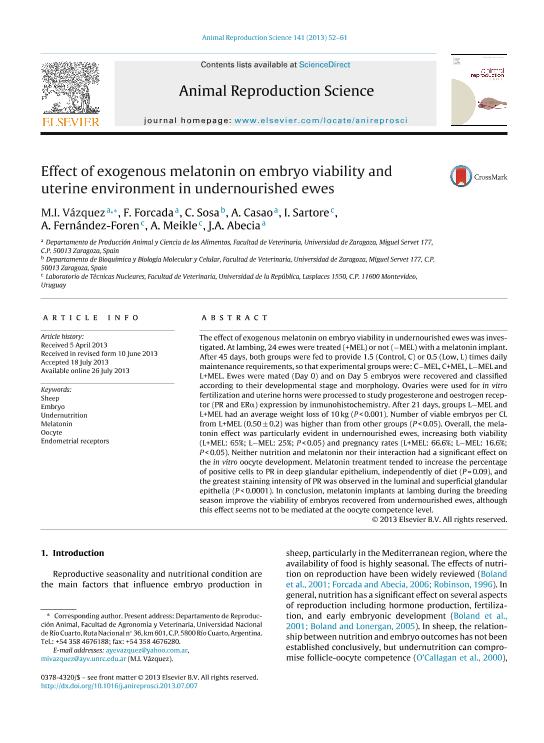Mostrar el registro sencillo del ítem
dc.contributor.author
Vazquez, Maria Isabel

dc.contributor.author
Forcada, F.
dc.contributor.author
Sosa, C.
dc.contributor.author
Casao, A.
dc.contributor.author
Sartore, I.
dc.contributor.author
Fernandez Foren, A.
dc.contributor.author
Meikle, A.
dc.contributor.author
Abecia, J. C.
dc.date.available
2017-09-12T16:21:11Z
dc.date.issued
2013-07
dc.identifier.citation
Vazquez, Maria Isabel; Forcada, F.; Sosa, C.; Casao, A.; Sartore, I.; et al.; Effect of exogenous melatonin on embryo viability and uterine environment in undernourished ewes; Elsevier Science; Animal Reproduction Science; 141; 1-2; 7-2013; 52-61
dc.identifier.issn
0378-4320
dc.identifier.uri
http://hdl.handle.net/11336/23994
dc.description.abstract
The effect of exogenous melatonin on embryo viability in undernourished ewes was investigated. At lambing, 24 ewes were treated (+MEL) or not (−MEL) with a melatonin implant. After 45 days, both groups were fed to provide 1.5 (Control, C) or 0.5 (Low, L) times daily maintenance requirements, so that experimental groups were: C−MEL, C+MEL, L−MEL and L+MEL. Ewes were mated (Day 0) and on Day 5 embryos were recovered and classified according to their developmental stage and morphology. Ovaries were used for in vitro fertilization and uterine horns were processed to study progesterone and oestrogen receptor (PR and ERα) expression by inmunohistochemistry. After 21 days, groups L−MEL and L+MEL had an average weight loss of 10 kg (P < 0.001). Number of viable embryos per CL from L+MEL (0.50 ± 0.2) was higher than from other groups (P < 0.05). Overall, the melatonin effect was particularly evident in undernourished ewes, increasing both viability (L+MEL: 65%; L−MEL: 25%; P < 0.05) and pregnancy rates (L+MEL: 66.6%; L−MEL: 16.6%; P < 0.05). Neither nutrition and melatonin nor their interaction had a significant effect on the in vitro oocyte development. Melatonin treatment tended to increase the percentage of positive cells to PR in deep glandular epithelium, independently of diet (P = 0.09), and the greatest staining intensity of PR was observed in the luminal and superficial glandular epithelia (P < 0.0001). In conclusion, melatonin implants at lambing during the breeding season improve the viability of embryos recovered from undernourished ewes, although this effect seems not to be mediated at the oocyte competence level.
dc.format
application/pdf
dc.language.iso
eng
dc.publisher
Elsevier Science

dc.rights
info:eu-repo/semantics/openAccess
dc.rights.uri
https://creativecommons.org/licenses/by-nc-nd/2.5/ar/
dc.subject
Sheep
dc.subject
Embryo
dc.subject
Undernutrition
dc.subject
Melatonin
dc.subject
Oocyte
dc.subject
Endometrial Receptors
dc.subject.classification
Ética relacionada con Biotecnología Agrícola

dc.subject.classification
Biotecnología Agropecuaria

dc.subject.classification
CIENCIAS AGRÍCOLAS

dc.title
Effect of exogenous melatonin on embryo viability and uterine environment in undernourished ewes
dc.type
info:eu-repo/semantics/article
dc.type
info:ar-repo/semantics/artículo
dc.type
info:eu-repo/semantics/publishedVersion
dc.date.updated
2017-09-06T19:01:23Z
dc.journal.volume
141
dc.journal.number
1-2
dc.journal.pagination
52-61
dc.journal.pais
Países Bajos

dc.journal.ciudad
Amsterdam
dc.description.fil
Fil: Vazquez, Maria Isabel. Universidad de Zaragoza; España. Consejo Nacional de Investigaciones Científicas y Técnicas; Argentina
dc.description.fil
Fil: Forcada, F.. Universidad de Zaragoza; España
dc.description.fil
Fil: Sosa, C.. Universidad de Zaragoza; España
dc.description.fil
Fil: Casao, A.. Universidad de Zaragoza; España
dc.description.fil
Fil: Sartore, I.. Universidad de la República; Uruguay
dc.description.fil
Fil: Fernandez Foren, A.. Universidad de la República; Uruguay
dc.description.fil
Fil: Meikle, A.. Universidad de la República; Uruguay
dc.description.fil
Fil: Abecia, J. C.. Universidad de Zaragoza; España
dc.journal.title
Animal Reproduction Science

dc.relation.alternativeid
info:eu-repo/semantics/altIdentifier/doi/http://dx.doi.org/10.1016/j.anireprosci.2013.07.007
dc.relation.alternativeid
info:eu-repo/semantics/altIdentifier/url/http://www.sciencedirect.com/science/article/pii/S0378432013002145
Archivos asociados
